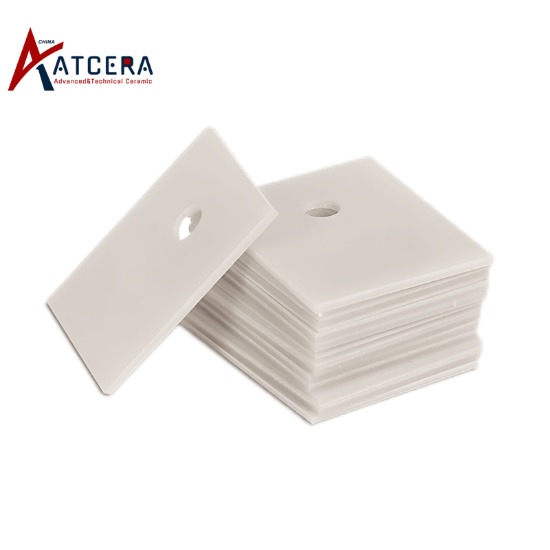Why is Aluminum Nitride the Ideal Choice for High Power LED Cooling Substrate Material
Excellent heat dissipation capacity is very important for LED, because in the process of converting electrical energy into light energy, there will be a large amount (70% to 80%) of the energy is converted into heat energy, and the greater the power, the more heat needs to be emitted. If these heat cannot be dissipated in time, the rise in junction temperature caused by them will not only lead to a reduction in LED output optical power, but also the chip will sharpen and accelerate, and the device life will be shortened, so LED products must ensure smooth heat dissipation. In the process of LED heat dissipation, the "package substrate" plays a very key role, so the development of high thermal conductivity heat dissipation substrate material has become an important way to solve the heat dissipation problem of LED devices and improve the luminous efficiency and service life of high-power LED.
With the increase of LED power, traditional resin substrates have long been unable to cope with their heat dissipation performance needs. Nowadays, the international research in this field is mainly focused on high thermal conductivity ceramic substrates with high thermal conductivity, thermal expansion coefficient matching semiconductor chips, and high insulation properties.
In the choice of ceramic materials, Al2O3 and BeO ceramics are the two main substrates to be considered for a long time, however, both have inherent shortcomings, such as Al2O3 has low thermal conductivity and thermal expansion coefficient that does not match the chip material; BeO has a high production cost and is highly toxic, which is not conducive to large-scale production. In addition, although SiC has a high thermal conductivity and the coefficient of thermal expansion is the closest to Si, its sintering temperature is as high as two thousand degrees, the preparation energy consumption is large, and the hot pressing production cost is high, which also limits its development and application as a substrate material.
In addition to the above, there is a better choice is aluminum nitride (AlN), which is one of the few ceramic materials with an interesting combination of high thermal conductivity and excellent electrical insulation properties, in addition, it is environmentally friendly and non-toxic, but also has high mechanical strength and chemical stability, can maintain normal working conditions in harsh environments. Therefore, as a high-power LED heat dissipation material is more suitable. The following table compares the properties of AlN to other common ceramic packaging materials.

The reason why aluminum nitride (AlN) is particularly suitable for use as a substrate, especially in the field of high-power leds, is mainly based on its series of excellent performance characteristics, which directly solve the key technical problems of LED heat dissipation, and significantly improve the overall performance and service life of LED devices. The following is a detailed explanation of the advantages of aluminum nitride as a substrate material:
Excellent thermal conductivity
Aluminum nitride has extremely high thermal conductivity, far exceeding that of traditional Al2O3 ceramic substrates. The high thermal conductivity means that the aluminum nitride substrate can more effectively conduct the heat generated by the LED chip to the cooling system quickly, thus significantly reducing the junction temperature of the LED chip. This is particularly important for high-power leds, because high-power leds will generate more heat at work, and if they cannot be dispersed in time, it will seriously affect their luminous efficiency and life.
Matching thermal expansion coefficient
The coefficient of thermal expansion of aluminum nitride is relatively close to that of LED chip materials (such as silicon), which helps to reduce thermal stress caused by temperature changes, prevent cracking or peeling of the interface between the chip and the substrate, and improve the reliability and long-term stability of the device.
Excellent electrical insulation performance
Aluminum nitride is not only a good thermal conductor, but also has excellent electrical insulation properties, which is critical for LED applications that require high electrical isolation. It ensures the safe operation of the LED circuit and prevents the failure caused by leakage or short circuit.
Environmentally friendly and non-toxic
Compared with toxic materials such as BeO, aluminum nitride is non-toxic and harmless, meets environmental requirements, and is suitable for large-scale production and application, reducing health risks and environmental impacts in the production process.
High mechanical strength and chemical stability
AlN substrate has high mechanical strength, can withstand greater mechanical stress and impact, while its chemical stability is also excellent, can maintain stable performance in a variety of harsh environments, extend the service life of LED products.
The preparation process is relatively friendly
Although the preparation process of aluminum nitride also requires a certain amount of technology and cost input, compared with high temperature sintered materials such as SiC, its sintering temperature is relatively low, the preparation energy consumption is small, and the hot pressing production cost is controllable, which is conducive to large-scale industrial production.
In conclusion, aluminum nitride with its high thermal conductivity, matched thermal expansion coefficient, excellent electrical insulation properties, environmental protection, non-toxic, high mechanical strength and chemical stability, and relatively friendly preparation process, become the ideal choice of high-power LED cooling substrate materials. It not only solves the problem of LED heat dissipation, but also improves the overall performance and service life of LED devices, and promotes the further development of LED technology.
评论
发表评论